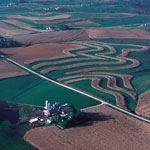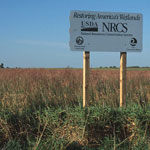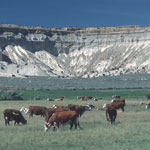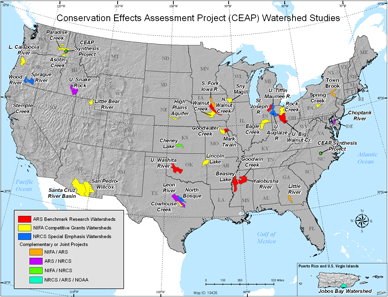Conservation Effects Assessment Project (CEAP)
CEAP is a multi-agency effort to quantify the environmental effects of conservation practices and programs and develop the science base for managing the agricultural landscape for environmental quality. Project findings will be used to guide USDA conservation policy and program development and help conservationists, farmers and ranchers make more informed conservation decisions.
Assessments in CEAP are carried out at national, regional and watershed scales on cropland, grazing lands, wetlands and for wildlife. The three principal components of CEAP—the national assessments, the watershed assessment studies, and the bibliographies and literature reviews— contribute to building the science base for conservation. That process includes research, modeling, assessment, monitoring and data collection, outreach, and extension education. Focus is being given to translating CEAP science into practice.
CEAP Vision... Enhanced natural resources and healthier ecosystems through improved conservation effectiveness and better management of agricultural landscapes.
CEAP Goal... To improve efficacy of conservation practices and programs by quantifying conservation effects and providing the science and education base needed to enrich conservation planning, implementation, management decisions, and policy.
. . . More about CEAP
What's New

-
Wetlands: USGS Scientific Investigations Report 2012-5266: A Regional Classification of the Effectiveness of Depressional Wetlands at Mitigating Nitrogen Transport to Surface Waters in the Northern Atlantic Coastal Plain, January 2013
-
Grazing Lands: Conservation Outcomes from Pastureland and Hayland Practices: Assessment, Recommendations, and Knowledge Gaps, Jerry Nelson, ed., December 2012
-
Wildlife: Conservation Insight—USDA Conservation Program Contributions to Lesser Prairie-Chicken conservation in the context of Projected Climate Change, December 2012 (PDF; 1.1 MB)
-
Wildlife: Conservation Insight—WRP Contributes to Amphibian Conservation in Missouri, December 2012 (PDF; 0.9 MB)
-
Grazing Lands: Science Note—Simulating the Effects of Fire on the ARS Reynolds Creek Experimental Watershed. December 2012 (PDF; 0.3 MB)
-
Grazing Lands: Science Note—Simulating the Effects of Brush Management on Runoff and Erosion on the ARS Walnut Gulch Experimental Watershed. December 2012 (PDF; 0.4 MB)
-
Watersheds: Hydrology and water quality of a field and riparian buffer adjacent to a mangrove wetland in Jobos Bay watershed, Puerto Rico, Ecological Engineering, December 2012 (PDF; 0.8 MB)
. . . More What's New

A sampling and modeling approach using data from representative crop fields, from the National Resources Inventory, and farmer surveys to estimate impacts of conservation practices on the environment. |

An effort to develop a collaborative foundation that facilitates the production and delivery of scientific data to inform conservation decisions affecting wetland ecosystems and the services they provide. |

A cooperative effort with the fish and wildlife conservation community involving multiple regional assessments that document habitat condition and biological response to conservation practices and programs at multiple spatial scales. |

An effort designed to quantify the environmental effects of conservation practices on non-Federal grazing lands in the United States. |

Forty-two CEAP watershed studies have been initiated to provide in-depth analysis and quantification of the measurable effects of conservation practices at the watershed scale and enhance out understanding of the effects of conservation in the biophysical setting of a watershed.
These studies are being conducted and/or supported by USDA's Agricultural Research Service, National Institute of Food and Agriculture, and Natural Resources Conservation Service. Future efforts will include translating this science into practice to better manage agricultural landscapes.
Current literature on conservation programs that documents what is known and not known about the environmental benefits of conservation practices and programs for cropland, fish and wildlife, wetlands, and grazing lands. The National Agricultural Library maintains dynamic bibliographies cataloging studies from 2003 to the present.
A full listing of all CEAP related documents published to date.

-
Wildlife: Conservation Insight—Applying the Sage-Grouse Fence Collision Risk Tool to Reduce Bird Strikes, November 2012 (PDF; 0.6 MB)
-
Watersheds: Outreach tool—NIFA-CEAP Watershed Synthesis Study: Steps to Citizen-based Watershed Planning: A Presentation For Watershed Planners, November 2012; (PPT; 15.2 MB)
-
Wetlands: Science Note—Conserving Prairie Pothole Wetlands: Evaluating Their Effects on Carbon Sequestration in Soils and Vegetation, October 2012 (revised December 2012) (PDF; 0.8 MB)
-
Cropland: Assessment of the Effects of Conservation Practices on Cultivated Cropland in the Missouri River Basin, August 2012
-
Watersheds: Findings released from NIFA-CEAP Watershed Synthesis Study: New book, fact sheets, and webcast are available, August 2012
-
Wildlife: Western Lake Erie Basin CEAP Biological Endpoints Partnership, May 2012
-
Wildlife: Wintering Waterfowl Respond to Wetlands Reserve Program Lands in the Central Valley of California, April 2012 (PDF; 2.3 MB)
-
Wildlife: Assessing Benefits of Conservation Practices to the Biological Integrity of Agricultural Streams in Michigan and Wisconsin, April 2012 (PDF; 6.8 MB)